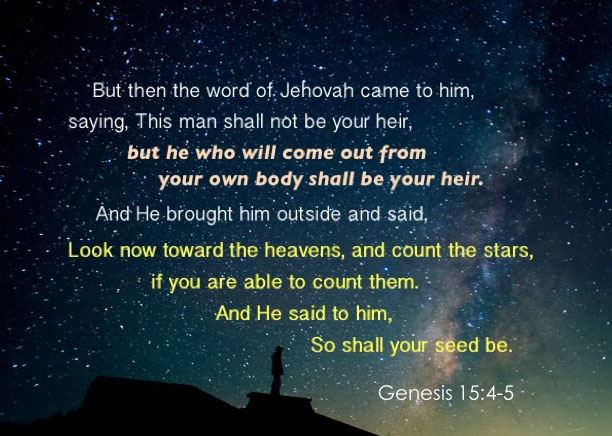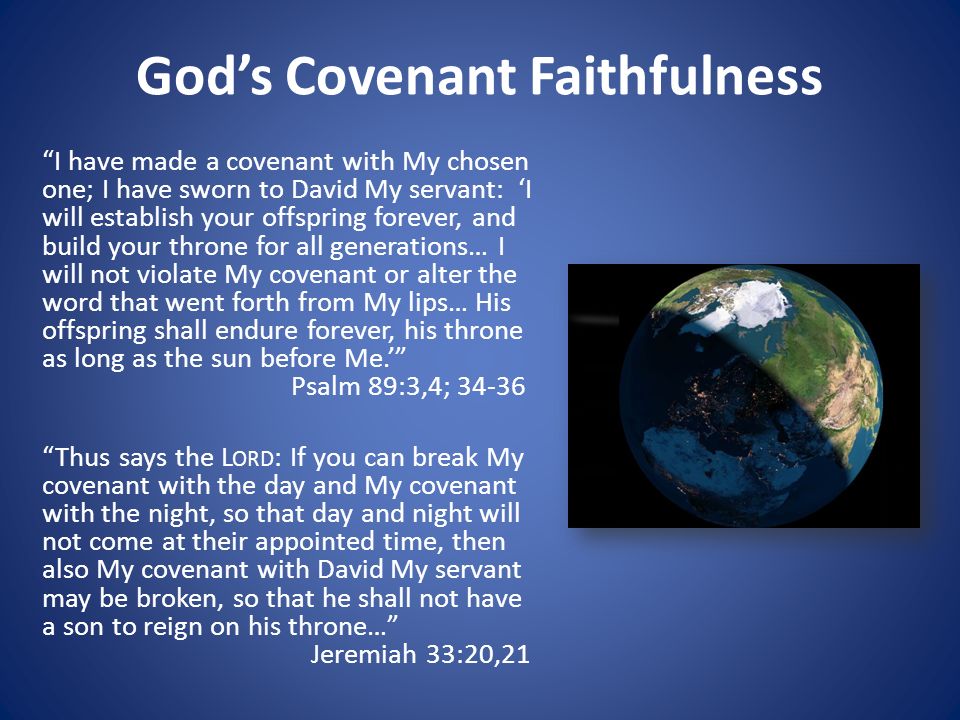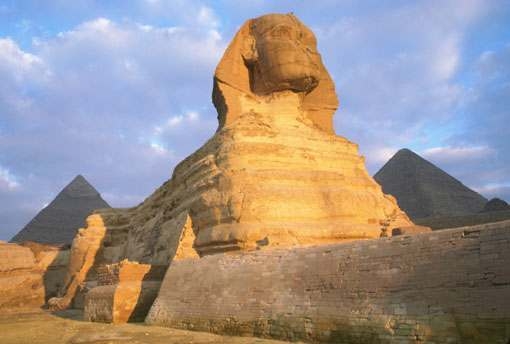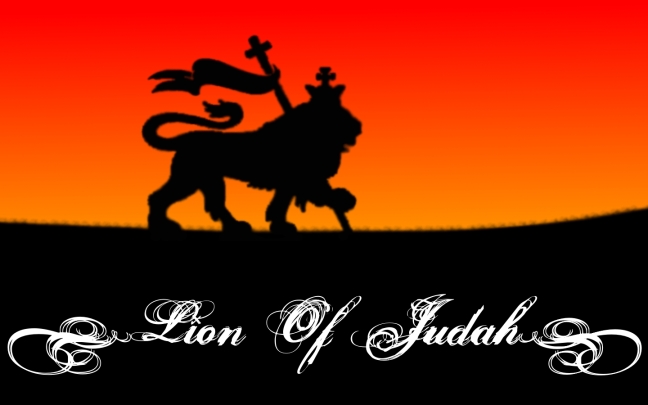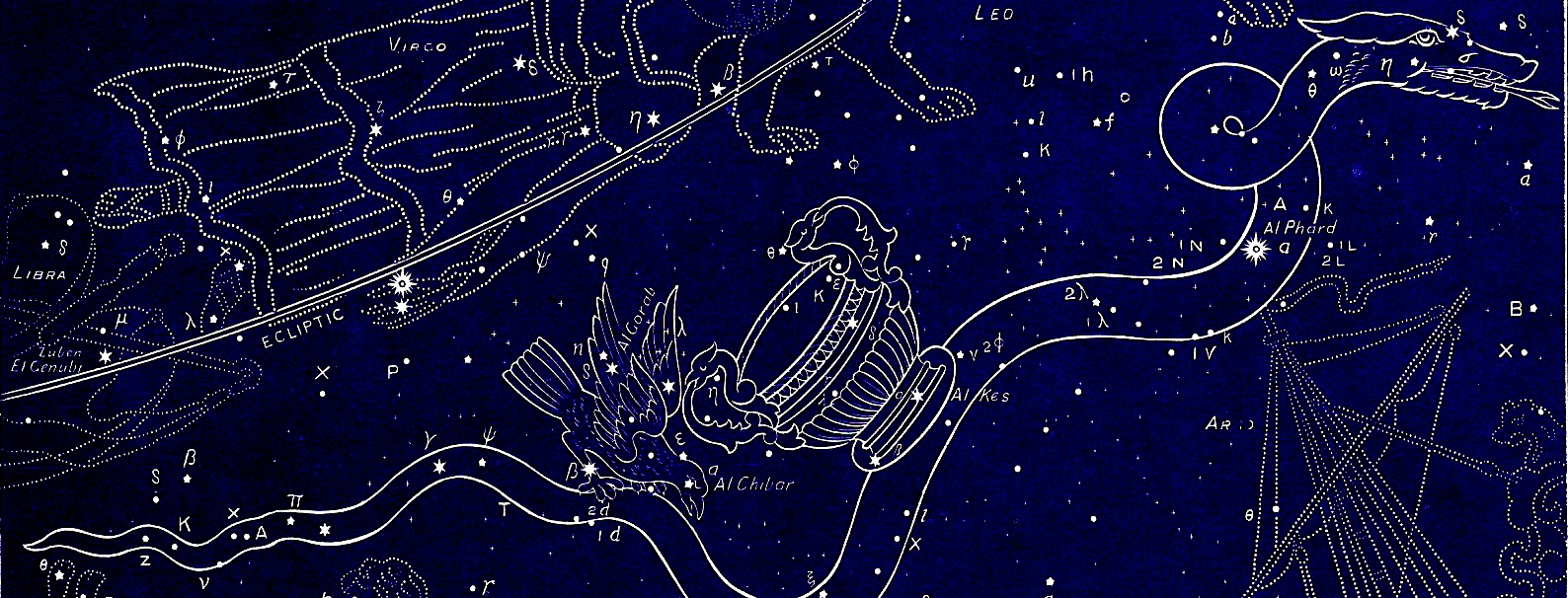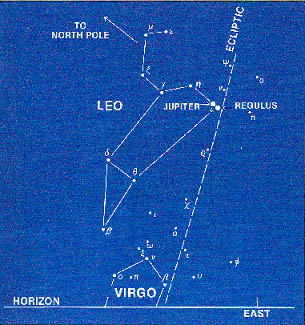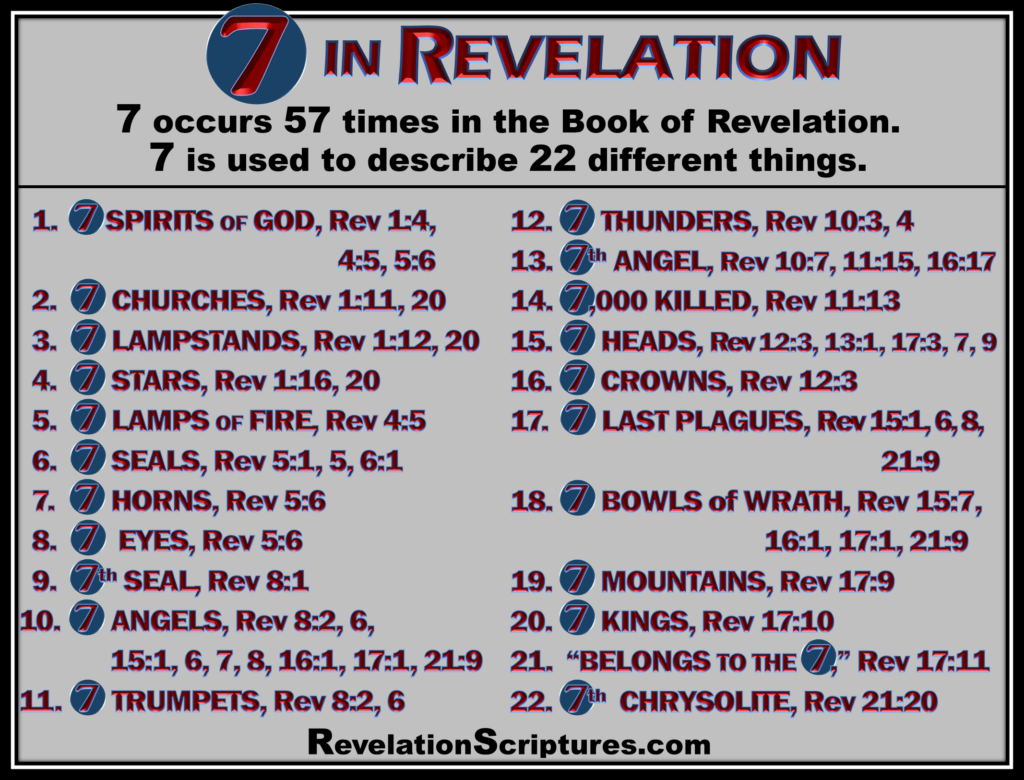
The Lunar Mansions Part 3, Dendera Lunar Decans
In Part 3 of our series on Lunar Mansions we will focus on the Lunar Decans of the Dendera Zodiac. In the first two parts of this series, we reviewed how the Lunar Mansions were preserved in ancient China, India, Isreal and Arabia. In Part 3 our focus is on ancient Egypt. The Dendera Zodiac is the best-known example of Egyptian zodiacal monuments, whose temple dates from the 1st century BC. The zodiac however, is believed to date far older than the temple housing it, going back at least to 2100 BC. Now housed in the Louvre, in Paris, the Dendera Zodiac displays a rounded ceiling vault with the 12 major signs, as well as the Egyptian northern and southern constellations, the planets, the sun and moon, and the 36 lunar decans, arranged around the periphery of the circular zodiac.
An early scientific study of Egyptian archaeological sites was conducted as part of Napoleon’s campaign into N. Africa. Bonaparte included French Archaeologists and language specialists to research key sites including the Giza Plateau. Many French scholars of the day believed the Dendera Zodiac to be thousands of years older than the Ussher’s date of creation. This was not the ideal or most politically expedient date for the “Holy Roman Empire,” but with the entrance of Champollion, as the foremost French Egyptologist in Napoleon’s reign, he provided a later incept date for the Dendera zodiac. As the first to decode the hieroglyphics on the famed Rosetta Stone, based on his study of Temple cartouches near the Temple’s ceiling location of the Dendera zodiac, he dated the royal names and by association, the Dendera Zodiac itself to a period between 50-200 BC. 1
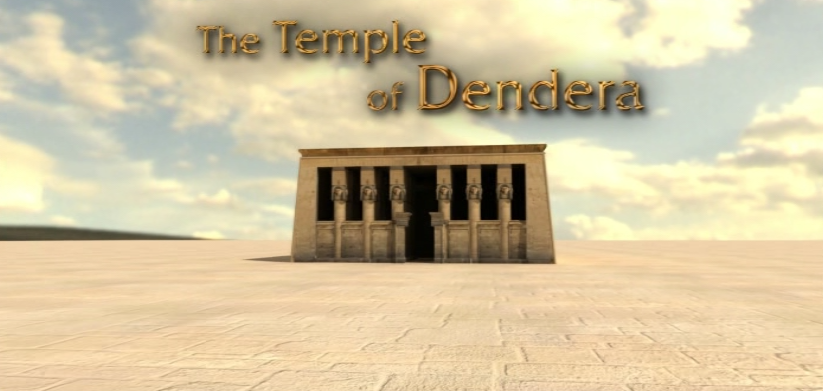
As a result, this late dating of the Dendera Zodiac has persisted in orthodox Egyptian archaeology to this day. But English scholars like Herman Lockyer provided evidence that the Dendera Temple housing the zodiac was probably “rebuilt at least three times since 3733 BC; once in the reign of King Pepi I, [which Lockyer dates at 3233 BC] once again by Thothmes III in 1600 BC, and finally by the Ptolemies about 100 BC. According to Lockyer the temple may have been aligned previously at the star Dubhe, which ceased to be circumpolar about 4000 BC, and before that at gamma Draconis, which ceased to be circumpolar about 5000 BC.” [2]
Lockyer also held that these historical rebuilds of astronomical Temples, based on changing star alignments, shows an awareness of the Precession of the Equinoxes in ancient Egypt, that far predated Hipparchus‘ supposed c.140 BC “discovery” of the precession of the Equinoxes. Another of these French Archaeologists; “Dupuis calculated the incept date of the Dendera Planisphere around 4000 BC.” 3 There is an obvious host of modern scholarship in agreement with Lockyer, opposing the orthodoxy of modern evolutionary archaeology, including “Hamlet’s Mill” authors George Santillianna and Von Dechend, who documented a number of tribal cultures like the Inuit, Persians, Norsemen, Native Americans, Hawaiians, Japanese, Chinese, along with the ancient Egyptians, who all recognized the sacred signs
and iconography of the precession of the equinoxes.
Champollion’s later date above, agrees with Lockyer’s date of the latest rebuild of the Dendera Temple by the Ptolemies around 100 BC, while ignoring the earlier temple rebuilds, going back to the Old Kingdom. As the oldest circular zodiac, Dendera holds a key place, not only in Biblical Archaeology, and Archaeo-Astronomy, but also with its system of Decans, from ancient Egypt, providing rare evidence supported in the most ancient texts, like the Pyramid Texts, predates any existing record for a Gospel in the Stars. In a recent critique of the writings of Frances Rolleston and the idea of the “Gospel in the Stars,” that she popularized in the later 1800’s, [Faulkner-2013] states;
“Not only are there no texts preserving the original knowledge of the gospel in the stars, but we know of no sources before Rolleston that claimed that there ever were such texts, or that any ever lived who believed such things. The first source we know of to make this claim is Frances Rolleston’s book. Let me be clear—it is obvious from Rolleston’s book that she had no texts that clearly taught her thesis. Instead, she created the meanings to support her thesis without reliance upon any older texts. The evidence we have that is most consistent with the gospel in the stars thesis not being an ancient idea at all, but entirely the invention of Frances Rolleston less than 200 years ago.”4
Faulkner continues;
“Although many ancient cultures referred to decans, they are defined differently than how Rolleston used the term. These cultures divided each astronomical sign into three decans. Since there are twelve signs circling the sky, each sign stretches over about 30° of the ecliptic. Thus, each decan spans roughly 10° along the ecliptic. Since it takes approximately 360 days for the sun to complete a circuit with respect to the stars, the sun occupies each decan for roughly ten days.“5
Faulkner’s description of how these “ancient cultures” calculated decans in their calendars, is an exact match for how the Egyptians calculated them related to the Dendera Zodiac.
Although our admiration and respect for Rolleston is great, due to her reliance on Scripture, our approach to Biblical Astronomy holds Biblical Scripture as the ultimate source of truth and the veracity of the Celestial Gospel. The evidence for the Gospel in the Stars we cite, comes primarily from the Scriptures of the Bible first and foremost, then is supported by historical research and secular sources in Biblical Astronomy. Few are aware of the evidence linking the Dendera Zodiac with prophecies of the birth of Christ, that I have advocated and posted [@try-god.com] for over 15 years, and continue to expand, including this blog in the Spring of 2020. Below is a Scriptural example of the three decans linked to Leo the Lion, highlighted in yellow. 6

Obviously, Faulkner is not familiar with the abundant Scriptural references to the Gospel in the stars, and the internal integrity of God’s Word at the basis of this subject, that provides all the ancient textual evidence required, far out dating Rolleston on this subject. Added awareness of how the ancient Egyptian monument, the Great Sphinx embodies the Alpha-Omega signs of the Hebrew Mazzaroth, with prophecies of the Birth of Christ, that adds historical support to the Dendera Zodiac. When taken with the other monuments of the Giza Plateau, the witness from ancient Egypt for the Gospel in the Stars becomes a deafening crescendo of truth, impossible to ignore for any honest seeker of evidence for an astronomical gospel. A key element of the Dendera zodiac is the recognition of the ancient Egyptian star names associated with it, and their meaning, compared to the Hebrew meanings of the same stars. This gives us a view of the similar approaches to practical Astronomy between the two cultures and the potential common source of these star names, from Biblical Patriarchs like Seth and Enoch, and how they convey the gospel message, prior to their corruption in the idolatry of the Egyptian star religion.
The Pyramids of the Giza Plateau

This evidence from the Dendera Zodiac, with its system of Decans predates the usage of decans in any of the oldest Greek or Latin texts by thousands of years, providing an ancient source far in advance of Rolleston’s writings, or even Ptolemy, as a basis for the Gospel in the Stars. We will explore the details of this in later blogs in 2020, as this blog serves to introduce the reader to some of the research in this field underlying Biblical Astronomy. This method of decan calculation was standard practice in ancient Egypt. With this ancient Egyptian historical background, we don’t have to rely on Faulkner’s opinion of how this ancient system of decans came together, since we have scholarly accounts from the oldest texts in history like the Pyramid Texts and the Book of Job, that make specific references to the decan system in ancient Egypt, based on the “Helical rising” of stars and asterisms used for time-keeping, from at least the end of the Old Kingdom in Egypt, [circa 2200 BC], if not earlier. 7
The Pyramid Texts, writings and tomb wall decorations, dating back to the Old Kingdom (2780–2250 BC) provide a bulk of decan references and ancient Egyptian creation myths. The progression of decan stars in Heliacal rising also explains how the series of 3 decans aligns with each of the 12 major constellations of the zodiac, giving a basis of the order of decans in the zodiac of Dendera, as stated by Rolleston and other Gospel in the stars advocates, witnessed with Leo’s three decans above.
Figure 1. Dendera Zodiac with 36 Lunar Decans. 8
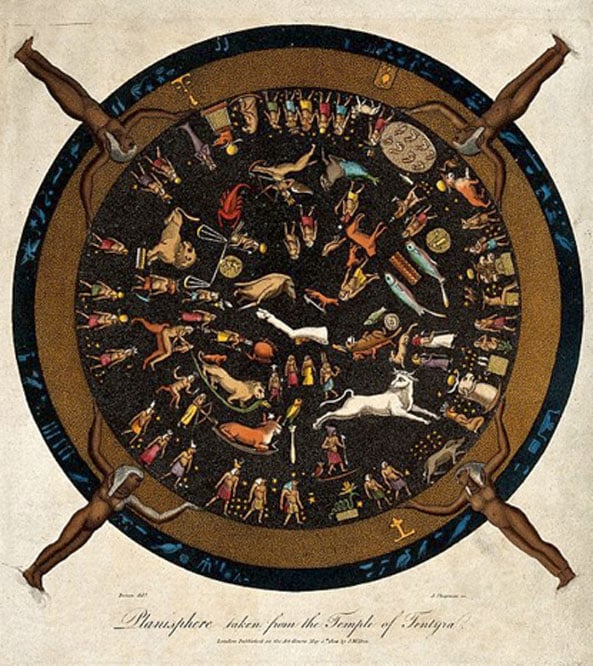
The color-coded image of the Dendera Zodiac below, shows specifically how the decans on the outer rim of this zodiac match up to the 12 main constellations in red, blue, orange, and Yellow. Another element of dominion seen in the four faces of the Cherubim, [Ezek. 1:5-6], shows what the Babylonians called the 4 royal signs, we find Aquarius–Man who is created after God’s image, with Leo the Lion the king of non-domesticated animals. With the Taurus the Bull as the king of domesticated animals, seen at the bottom cardinal point with the sign of the Bull in Fig. 3. and the Eagle-Aquila, king of the fowl of the air, [Gen.1 26-28], we find a composite image of these four signs of the zodiac in the Cherubim. These four Cardinal Directions, of the Hebrew Mazzaroth provide a template for the 12 major signs both in Egypt and Israel. [Num. 24:7-9]
Figure 2. A color-coded image of the Dendera Zodiac. 9
Schwaller De Lubicz is another scholar who argued in favor of the ancient Egyptian knowledge of precession. He points out 2 hieroglyphs on the outer rim of Dendera’s zodiac that mark a line between Aries the Ram and Taurus the Bull, correlating to a date around 2200 BC, in Fig. 3 indicating how the Egyptians wanted to mark the transition in ages of precessional ages, in this case from the age of Taurus to that of Aries. As De Lubicz states;
“The mere fact that the cult of the Bull [Apis/Mentu] preceded the cult of the Ram [Amon]
in Egypt, and that the dates of these cults correspond to the equinoctial positions of their constellations at the appropriate time-approximately 4000 and 2000 BC-is conclusive.“10
According to Schwaller DeLubicz, this was conclusive evidence that the ancient Egyptians were not only aware of, but applied their knowledge of the precession of the equinoxes. This evidence also speaks volumes concerning the age of the Dendera Zodiac, documenting this transition of the precessional ages of Taurus to Aries, following other elements of the calendar system inherent in the Dendera Zodiac before 3000 BC.
Figure 3. Overlaid Zodiacs of the Celestial Pole and Ecliptic Pole of the Dendera Zodiac. 11
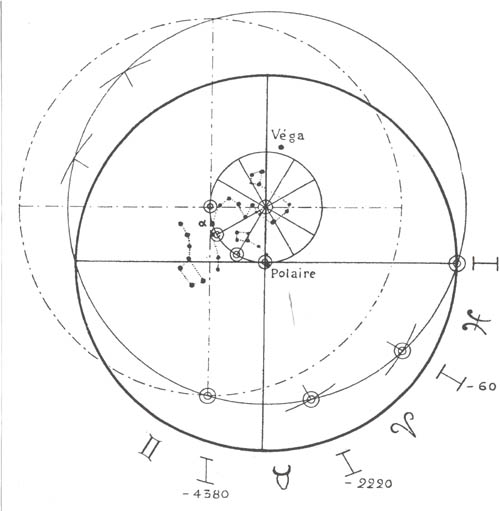
As we can see in Figure 3 above, the receding pole star is mapped on the smaller inner center circle, along with a series of four points related to the four axes on the larger outer circle of the zodiac. This shows us the pole star in the specific precessional ages going back to the Age of Gemini, marked on the larger zodiacal circle by the symbol “II“, prior to 4380 BC, portrays the transition from the Age of Gemini to the Age of Taurus. This depicts Gemini’s position at the early stages of Egyptian reckoning of precessional ages in Dendera’s zodiac, even though the latest version of the Temple of Dendera housing
this zodiac, was rebuilt in the late Hellenistic period.
Most of the prevailing sentiment in orthodox archaeology holds an evolutionary view where the sophistication of astronomical understanding of concepts like precession was beyond the ken of “primitive” cultures, despite abundant evidence to the contrary. The orthodoxy finds itself at a loss to explain how ancient history does not conform to their evolutionary view of increased astronomical sophistication with the passage of time, instead, they are faced with a reality where the older and superior application of this knowledge was corrupted by the mythology and idolatry of later cultures in the ancient world. As E.W. Bullinger stated:
“All the ancient systems of idolatry connected with Astrology and mythology were in the same way, not original inventions of what was new but the corruption of what was old,
and the perversion of original truth.”12
Figure 4. Ancient Archaeological depictions of the Precessional Age of Taurus the Bull.
This reflects a history of Dendera’s temple and associated Zodiac extending back into Pre-dynastic ages coincident to the Precessional Age of Taurus. We take added note of their recognition of the Precession of the Equinoxes in ancient Egypt, and how early Pharaohs took their titles. Starting with the Menuhopteps, and Menes/ Narmer, who ruled before the Amenhoteps in Pharaonic historical progression. Notably, the Old Kingdom Pharaohs adopted Mentu the Bull in their titles during latter parts of the Precessional Age of Taurus, before the precessional shift to the Age of Aries, around 2200 BC. This transition of ages of the precession of the equinoxes, occurred when the retrograde motion of the Sun caused the sunrise in successive signs of the zodiac every 2.160 years, opening a new precessional age.
Figure 5. Pharaoh Rameses II linked with the Precessional Age of Aries in a Ram-headed Sphinx.
Once the Age of the Ram Aries began, the Pharaohs began honoring the Ram-Amon in their kingly titles. During this period and following was also when Ram-headed Crio-sphinxes began showing up in Egyptian iconography, as a representation of their creator-god Khnum, who they believed, fashioned the universe out of clay. This also accounts for Khnum’s association with the fertility of soil and the annual inundation of the Nile, marked by the star Sirius. As Khnum’s influence grew in power in Egyptian pantheons, the symbolism of the previous precessional Age of Taurus decreased in value. Egyptologist Richard Parker deciphered early symbols carved on an ivory tablet from the First Dynasty as: “Sirius, the opener of the year, the innundation.” As Krupp observes: “This implies that the basic elements of the calendar system were in place by 3100 BC. The same celestial calibrations endure all the way into the Ptolemaic period, 3,000 years later.“ [13]
This 1st Dynasty Ivory plaque depicts the star Sirius as a hieroglyph of a reclining Cow with the Sun above her head, easily visible in similar form in the Dendera zodiac, marking not only the decan to open the New Year, but also denotes the precession of the equinoxes. Since Isis embodied this reclining cow pictured with a star between bovine horns, seen just above the “Decans” label in the lower-left corner of Fig. 6, below, providing strong evidence of the use of the Sirius cycle, or Sothic Calendar in ancient Egypt, as a testimony to their advanced astronomical practices and recognition of precession
early on.
Figure 6. Dendera Zodiac cast at the Rosicrucian Museum-San Jose, CA. 14

The significance of the coordination of the lunar and solar cycles in the context of this New Year’s celebration is that the Heliacal Rising of Sirius also qued the Egyptians to add an Intercalary month, keeping the calendar’s lunar cycles in line with the solar seasons. This luni-solar coordination also applies in view of the unity of lunar decans with the solar zodiac of 12 Constellations, on the Dendera Zodiac, not in disjointed separation. The calendars with long-standing and wide-spread use in Egypt included those of both administrative and religious uses. They date from Egypt’s unification around 3000 BC. The civil calendar consisted of 365 days, with 12 months of 30 days, and each month named for religious holidays during that month. On this lunar plan, each month consisted of 3 weeks, of 10 days, in-synch with their 36-decan system.
As the only circular astronomical model to be found in Egyptian antiquity, Dendera’s Zodiac depicts the 360 days of the Egyptian year, with decans arranged on the outer edge of the circular zodiac. Twelve signs with 3 decans each, in the 360-day year, even with a 37th decan allowing for the 5 extra days of the year, totaling 365 days of the Sothic Calendar. Figure 7 shows images of the specific star groups and asterisms in heliacal rising every 10 days on the Dendera Zodiac.
Figure 7. 36 Decans of the circular Dendera Zodiac with their star signs.

As we have documented in parts 1 and 2 of this series on the Lunar Mansions, the Chinese, Arab and Indian zodiacs applied 28 Lunar Houses distinct from these 36 Decans. Some hold that the decans predate the use of the 12 signs in ancient Egypt to divide the ecliptic, but the Egyptian recognition of the ages of the precession of the equinoxes pointed out above, is contrary to that notion. It appears more likely that the decans were directly linked to each of the 12 tropical signs of the zodiac initially, in alignment with the theme of the Gospel in the stars. Thus the lesson of the decan supports that of the 12 constellations, even as we see with Leo’s destruction of the serpent- Hydra above. Bullinger tells us the Egyptian name for Leo was Pi Mentekeon, which means the pouring out, in reference to pouring out of divine wrath, as seen in the decan-Crater, the cup holding God’s wrath in the judgment of Christ’s victorious return, [Rev. 14:10, 16: 19]. The 3rd decan of the Raven Corvus also adds to this theme in one of the decan star names called Minchar al Gorab, meaning Corvus tearing to pieces the serpent’s remains;
[Prov. 30:17, 1 Sam. 17:46]. 15
This attests to the integrity of the stellar witness, with all its elements reflecting the same truths of Scripture, as seen in the 19th Psalm. These ancient lunar calendar decans marked the Lunar Mansions, but due to inconsistent records of Decan stars, there was an occasional lack of consensus in Egypt, so with the exception of Sirius, the rest of these 36 decans endured several transformations during the Hellenistic period. 16
A good source for a specific list of these decan stars from the Middle Kingdoms was from an office-holder under Queen Hatshepsut (c. 1450 BC) of Egypt named Sesenmut, was buried near the queen’s tomb. On the ceiling of his burial monument was found an excellent example, from the Age of Aries of these 36 decans listed below.
Figure 8. The Decans of Senenmut’s Tomb 17
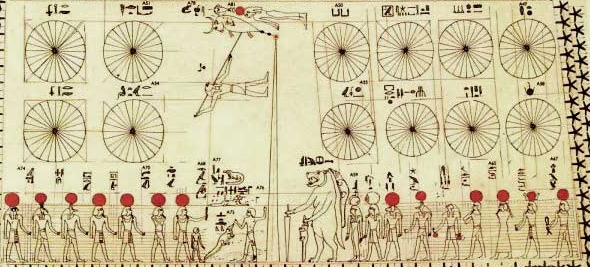
The Egyptians divided the decans of the night sky in different constellations in a way similar to modern astronomy. Senenmut’s Tomb is a great example of the decans in painted ceilings of different Egyptian tombs, that allow us to establish their number from tomb to tomb. In spite of periodic uncertainty, it seems there were at least 36 decans consistently depicted. Egyptians divided the year in 5 days plus 36, 10-day periods, corresponding to the 10 days of consecutive risings of decan stars recorded in Senenmut’s tomb, listed below:
- tpc-knmwt. A set of three stars represented by a man with a solar disk on his head. It is linked to Geb. [Canis Major]
- knmwt. A boat with a head of a snake in the ship’s bow with a standing boy with one finger in his mouth. It is associated to Isis or Ba. [Canis Major]
- hr-hpt-knmwt. A set of three stars seen in a tailed man with a bird’s head with a double crown. It is linked to Isis or Horus’ sons. [Cancer]
- h3t-d3t. A set of four stars represented by a falcon-headed man with 2 big feathers. It is associated to Isis or Hours’ sons. [Leo]
- phwy-d3t. A set of three stars seen in a man with a white crown on his head and a scepter in his hand. It is linked to Horus’ sons. [Leo]
- tm3-hrt. A set of three stars represented by a man with two big feathers on his head and a scepter in his hand. It is associated to Duamutef or Mesti. [Virgo]
- tm3-hrt. A set of three stars seen in a falcon-headed man with horns and a solar disk over them. He also holds a scepter in his hand. It is linked to Duamutef or Qeehsenuef. [Virgo]
- wsti. A man with the solar disk rounded by a royal snake. It is associated to Duamutef. [Virgo]
- bk3ti. A man with the double crown and a scepter in his hand. It is linked to Duamutef. [Virgo]
- tp-c–hntt. Two stars represented by a falcon-headed man with a solar disk on his head and a scepter in his hand. It is associated to Duamutef or Hapy. [Scorpio]
- hntt-hrt. A set of two stars represented by a tailed man with a stick and a scourge in his hands. It is linked to Horus. [Scorpio]
- hntt-hrt. A set of four aligned stars seen in the four aligned stars, a head and an arm on a ship. It is associated to Seth. [Scorpio]
- tms-n-hntt. Three aligned stars represented by a baboon on a ship in front of a lunar disk. It is linked to Horus. [Scorpio]
- s3pt–hnnw. A set of 2 stars seen in Anu a falcon-headed man with a scepter in his hand. It is associated to Isis or Nephtis. [Scorpio]
- hr-ib-wi3. A set of four stars represented by a falcon-headed man with a solar disk on his head and a scepter in his hand. It is linked to Seth or Ur. [Scorpio]
- shsmw. Two stars seen in a man with a snake and a scepter in his hand. It is associated to Seth or Ur. [Serpens]
- knmw. A headless man with a solar disk on his shoulders. It is linked to Hapy or Duamutef. [Serpens]
- smdt. Three stars represented by a tailed man with a double crown. It is associated to Horus. [Capricorn]
- tpc–smdt. A tailed man with a double crown. It is linked to Hapy. [Capricorn]
- srt. A set of four stars seen in a falcon-headed man with the ateph crown and an animal tail in his skirt. It is linked to Isis. [Aquila]
- s3wy-srt. Two stars seen in a woman with a scepter in her hand. It is associated to Duamutef. [Aquila]
- hr-hpt-srt. A tailed man with scepter in hand, linked to Qebehsenuef. [Aquila]
- 3hwy. A tailed jackal headed man with a scepter in his hand. It is associated to Duamutef. [Pisces]
- b3wy. A set of 3 stars represented by a tailed ibis headed man with the ateph-crown and a scepter in his hands. It is associated to Duamutef. [Pisces-Cepeus]
- hnt-hrw. A tailed falcon-headed man with a tadpole. It is linked to Hapy or Mesti.
- hr-ib-hntw. A tailed falcon-headed man. It is associated to Horus. [Aries]
- hnt-hwr. A boy with one of his fingers in his mouth sitting on a lotus flower. It is linked to Horus. [Aries]
- kd. Three stars represented by a boy with one of his fingers in his mouth sitting on a lotus flower and a solar disk on his head. It is associated to Horus. [Taurus]
- s3wy-kd. Two stars seen in a tailed man with the ateph crown and a scepter in his hand. It is linked to Horus. [Taurus]
- crt. A tailed man with a papyrus plant. It is associated to Qebehsenuef. [Taurus]
- h3w. Four stars seen in a tailed falcon-headed man with the double crown. It is associated to Hapy. [Taurus]
- rmn-hrw-inw-s3h. 18 stars seen in a tailed man with the white crown and a scepter in his hand. It is linked to Mesti. [Aries]
- msdr-s3h. A lioness headed woman with a royal snake and a crosier in her hand. It is associated to Duamutef. [Orion]
- rmn-hr-s3h. Three stars seen in a man with the white crown with a feather sitting on a throne. It is associated to Horus. [Orion]
- c–s3h. An ibis-headed man with the ateph crown and a scepter in his hand. It is associated to Horus. [Orion]
- s3h. Its corresponding is Orion and it’s represented by two ships. On the first one there are three people: a boy with one of his fingers in his mouth and a double crown on his head, a horned woman with a solar disk on her head and another woman with 2 feathers and the solar disk between them. On the other ship there is a snake in a lotus flower. It is associated to Maat-Horus.
- spdt. Its corresponding star is Sirius and seen in a tailed falcon-headed man with a solar disk on his head and a scepter in his hand. It is associated to Isis. 18
This evidence reflects a long-standing history from Old Kingdoms and even Pre-dynastic ages of ancient Egypt of astronomical themes in support of the Gospel in the Stars. My encouragement to the reader is to review the links included here and the key background provided in presenting the case for the “Gospel in the Stars,” and Biblical Astronomy. Awareness of these related topics, present a more comprehensive view of Biblical Astronomy, depicting a grasp of sub-categories in this study, and how they support and inter-relate to the larger context.
God Bless!
Rene‘

Footnotes
1. [https://www.ancient-origins.net/artifacts-other-artifacts/circular-egyptian-mythology-does-dendera-zodiac-represent-most-ancient-021599]
2. Secrets of the Great Pyramid, Peter Thompkins, p.168
3. The Mazzaroth, Antiquity of the Chaldean and Egyptian Constellations, Frances Polleston
4. https://answersingenesis.org/astronomy/stars/a-further-examination-of-the-gospel-in-the-stars/
5. IBID
6. https://www.pinterest.com/pin/338614465705844552/ [picture credit]7
7. The Senenmut Project-Introduction, Jose Lull
8. [https://www.ancient-origins.net/artifacts-other-artifacts/circular-egyptian-mythology-does-dendera-zodiac-represent-most-ancient-021599] [picture credit]
9. https://www.starmythworld.com/mathisencorollary [picture credit]
10. The Skies in Memory, John Lash as quoted in The Atlantis Blueprint, Wilson & Flem-Ath. p. 169
11. Secrets of the Great Pyramid, Peter Thompkins, p.172
12. Companion Bible, App. 42, EW Bullinger.
13. Echoes of the Ancient Skies, p.172, E.C. Krupp
14. Dendera Zodiac cast at the Rosicrucian Museum-San Jose, CA. [picture credit]
15. Witness of the Stars, p. 163, 168. EW Bullinger.
16. The Discovery of Time, ppg. 82-83, Stuart McCready
17. https://themathematicaltourist.wordpress.com/2012/10/13/the-decans-in-senenmuts-tomb/ [picture credit]
18. IBID
Comments on Facebook


![[AAO Photograph]](https://www.naic.edu/~gibson/pleiades/ukschmidt/pleiades_ukschmidt_clean_names.jpg)
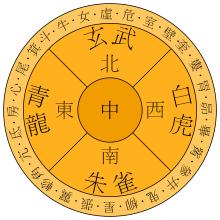



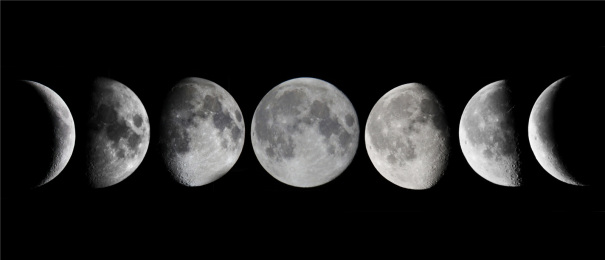
/moon_phases-58b84a765f9b5880809d8d4d.png)
